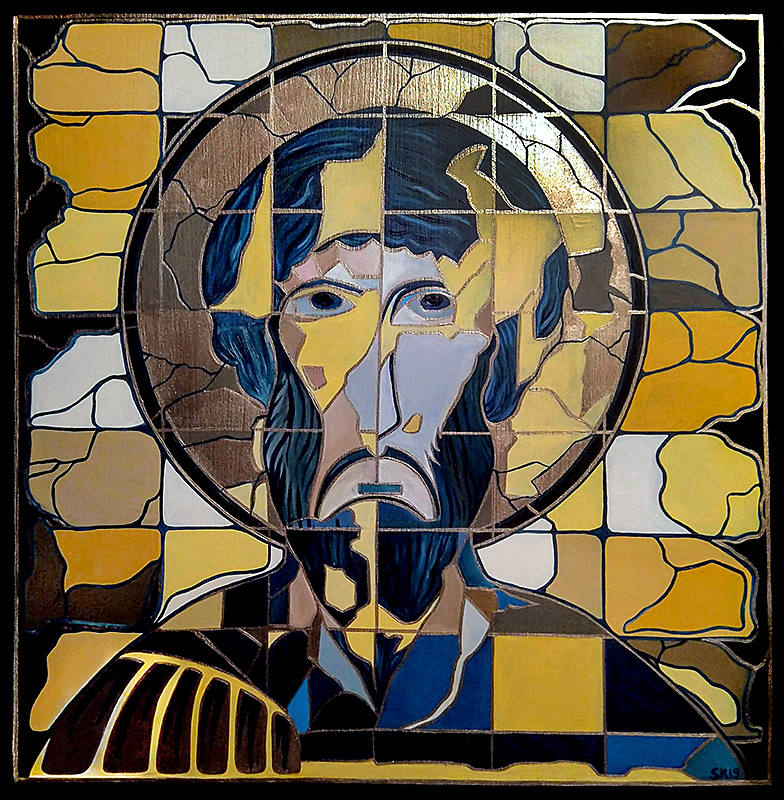- Year 2019
- Media Wooden panel, acrylic paint, golden gilding paint
- Dimensions 50 x 50 cm
- Availability Reserved
- View more GALLERY
Saint Theodore Stratelates
The painting “WARRIOR SAINT, ST. THEODORE STRATILATES” is part of the “De Personeae” (Personalities) cycle aiming to arrive at my own interpretation of images of personalities representing various cultures and symbolic ideas.
For me he is one of the important archetypes of the Warrior-Saint concept. What did it mean to be a Warrior-Saint? Saints intervened in ordinary people’s lives by performing good deeds or miracles, they warded off demons, protected people on their journeys, cured their illnesses, and helped them become wealthy if they were poor. They also protected the soldiers in numerous armies. They themselves were originally soldiers in the Roman army who had secretly adopted Christianity for which they were persecuted. Very often they became martyrs.
The cult towards the Warrior-Saint was largely independent until the 10th century when emperors developed an increased interest in the sacred nature of warfare. The development within the Byzantine army of an interest in the role of religion in warfare, and in the relationship of soldiers to martyrs in particular, is essential to understanding the development of the cult to military sainthood.
St. Theodore Stratilates was one of the most recognizable Warrior-Saints together with St George, St Demetrius and others. St Theodore was a soldier and a devout Christian in Asia Minor (Anatolia, modern day Turkey). His bravery was revealed after he, with the help of God, killed a giant serpent. The beast had devoured many people and animals, terrorizing the countryside of his town. Thus, for his bravery, St. Theodore was appointed military commander, “stratelatos”, in the city of Heraclea Pontica where he combined his military service with preaching the Gospel among the pagans. His mastery in persuasion, reinforced by his personal example of Christian life, convinced many to accept Christianity.
I chose the story about the Warrior-Saint because it characterizes the important qualities of every person who dares to directly or figuratively call themselves warrior in life: the will to achieve an aim by way of patience, willfulness, perseverance and persuasiveness.
St Theodore died a martyr’s death in 319 AD as a defender of the Christian faith during the reign of Roman Emperor Licinius I (r. 308-324 AD). To this day he is regarded as the patron saint of soldiers and is venerated with the title Great-martyr in almost all Christian churches in Europe and the Near East. He was also mentioned as a patron of Venice before St Mark.
The painting “ST THEODORE STRATILATES” is based on the devoted to the saint oldest Bulgarian-made ceramic icon dating back to the 10th century AD. The icon, of which no analogue exists in the world, was found in the beginning of the 20th century during archaeological excavations of the medieval Bulgarian monastery “Saint Panteleymon” in Patleyna located 2 km south of Veliki Preslav, today a small town in Northeast Bulgaria. St Theodore Stratilates was also patron of the first Bulgarian capital city – Veliki Preslav – during the first Bulgarian kingdom (893 – 970 AD). He was connected with the reign of Tsar Simeon the Great (893-927 AD) and the period known as the First Golden Age of Bulgarian literature and culture. At the time, Patleyna was among the leading centers of the Preslav Literary School and the biggest producer of painted decorative ceramic images consisting of separate ceramic tiles. They were also utilized in a number of churches built in the town of Nessebar on the Black sea coast in Bulgaria.
This story about the Warrior-Saint Theodore Stratilates together with the unique ceramic icon from the 10th century, gave me the courage to create my own version of his image.
